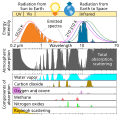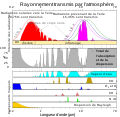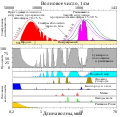Ficheiro:Atmospheric Transmission.svg

Tamaño desta vista previa en PNG do ficheiro en formato SVG: 614 × 600 píxeles. Outras resolucións: 246 × 240 píxeles | 491 × 480 píxeles | 786 × 768 píxeles | 1.048 × 1.024 píxeles | 2.096 × 2.048 píxeles | 741 × 724 píxeles.
Ficheiro orixinal (ficheiro SVG; resolución de 741 × 724 píxeles; tamaño do ficheiro: 321 kB)
Historial do ficheiro
Prema nunha data/hora para ver o ficheiro tal e como estaba nese momento.
| Data/Hora | Miniatura | Dimensións | Usuario | Comentario | |
|---|---|---|---|---|---|
| actual | 18 de abril de 2023 ás 16:19 |  | 741 × 724 (321 kB) | Efbrazil | Adding white background color so renders correctly on smartphone |
| 7 de agosto de 2022 ás 20:29 |  | 741 × 724 (321 kB) | Efbrazil | color bug fix | |
| 7 de agosto de 2022 ás 20:00 |  | 741 × 724 (321 kB) | Efbrazil | Fixed translations as best as possible using text editor for new layout | |
| 7 de agosto de 2022 ás 19:34 |  | 741 × 724 (320 kB) | Efbrazil | Fixing text alignment | |
| 7 de agosto de 2022 ás 19:26 |  | 741 × 724 (320 kB) | Efbrazil | Graphical improvements as per discussion page | |
| 17 de febreiro de 2022 ás 17:59 |  | 741 × 724 (208 kB) | Pierre cb | File uploaded using svgtranslate tool (https://svgtranslate.toolforge.org/). Added translation for fr. | |
| 18 de marzo de 2021 ás 22:10 |  | 741 × 724 (180 kB) | Cepheiden | german labels adjusted | |
| 18 de marzo de 2021 ás 22:09 |  | 741 × 724 (180 kB) | Cepheiden | correction of labels | |
| 18 de marzo de 2021 ás 22:06 |  | 741 × 724 (180 kB) | Cepheiden | File uploaded using svgtranslate tool (https://svgtranslate.toolforge.org/). Added translation for de. | |
| 18 de marzo de 2021 ás 21:52 |  | 741 × 724 (154 kB) | Cepheiden | =={{int:filedesc}}== {{Information |description= {{en|1=This figure shows the absorption bands in the Earth's atmosphere (middle panel) and the effect that this has on both solar radiation and upgoing thermal radiation (top panel). Individual absorption spectrum for major greenhouse gases plus Rayleigh scattering are shown in the lower panel.}} |date=2021-03-18 |source=This figure was prepared by Robert A. Rohde for the Global Warming Art project. |author=[[User:Д.Ил... |
Uso do ficheiro
A seguinte páxina usa este ficheiro:
Uso global do ficheiro
Os seguintes wikis empregan esta imaxe:
- Uso en ar.wikipedia.org
- Uso en de.wikipedia.org
- Uso en el.wikipedia.org
- Uso en en.wikipedia.org
- Uso en fr.wikipedia.org
- Uso en ha.wikipedia.org
- Uso en ig.wikipedia.org
- Uso en pt.wikipedia.org
- Uso en simple.wikipedia.org
- Uso en zh.wikipedia.org










